Robotic Process Automation (RPA): Revolutionizing Workflow Efficiency
In the consistently evolving scene of business operations, associations are continually seeking ways of enhancing efficiency, decreasing expenses, and remaining cutthroat in the digital age. One transformative technology that has arisen as a central participant in achieving these objectives is Mechanical Process Automation (RPA). RPA, often alluded to as the distinct advantage in workflow automation, has been demonstrated to be an impetus for business process optimization and digital transformation.
Understanding Robotic Process Automation (RPA)
At its center, Mechanical Process Automation involves the use of software robots or ‘bots’ to mechanize tedious, rule-based undertakings within business processes. These bots are furnished with the capacity to mirror human activities, interact with digital situations, execute predefined undertakings, and control information. RPA technology uses automation tools to streamline business processes, diminish mistakes, and let loose HR for more key and worth-added exercises.
RPA Technology: A Gateway to Enhanced Workflow Efficiency
The reception of RPA technology is driven by the quest for enhanced workflow efficiency. Associations are recognizing the capability of RPA solutions to bring about a change in outlook in how undertakings are performed. Via automating ordinary and tedious undertakings, RPA permits representatives to zero in on high-esteem exercises that require imagination, decisive thinking, and vital direction.
Business Process Optimization through RPA Implementation
The integration of RPA into business operations denotes a huge step towards business process optimization. Automation tools for efficiency assume a urgent part in identifying and automating dreary processes, reducing functional expenses, and improving precision. RPA solutions, when decisively executed, lead to streamlined business processes that are quicker as well as more solid.
Digital Transformation with RPA: A Strategic Imperative
In the period of digital transformation, associations are leveraging RPA to speed up their excursion toward a more deft and educated future. RPA in business operations goes about as an impetus, enabling associations to consistently embrace change. The capacity to adjust and develop because of market elements is a critical part of remaining cutthroat, and RPA works with this progress by providing an adaptable and versatile automation structure.
Intelligent Automation: Unleashing the Power of RPA
While standard automation focuses on rule-based errands, intelligent automation makes it above and beyond by incorporating portions of man-made brainpower (reproduced intelligence) and machine learning (ML). RPA, associated with recreated intelligence, brings about intelligent automation, where bots perform routine errands as well as learn and have a significant impact in context on involvement. This degree of intricacy refreshes the efficiency and flexibility of business processes, making them more grounded to change.
Process Automation Benefits: Beyond Time and Cost Savings
The benefits of RPA implementation stretch out a long way past the domain of time and cost savings. Enhanced workflow efficiency is only a glimpse of something larger. RPA in business operations prompts increased precision, decreased mistakes, further developed consistency, and enhanced consumer loyalty. The automation of redundant errands additionally mitigates the gamble of worker burnout, allowing HR to zero in on undertakings that require imagination and the capacity to appreciate anyone on a deeper level.
Streamlining Business Processes with RPA Solutions
The sending of RPA solutions involves a fastidious examination of existing business processes. Identifying regions where automation can add esteem is critical for fruitful RPA implementation. Streamlining business processes with RPA requires a cooperative effort involving business examiners, IT professionals, and end-users. Through this cooperative methodology, associations can guarantee that RPA lines up with their essential targets and conveys substantial outcomes.
Cognitive Automation: Integrating RPA with Cognitive Technologies
Cognitive automation, a significant level form of automation, integrates RPA with cognitive advances like normal language processing (NLP) and machine learning. This integration empowers bots to manage unstructured information, seek after informed decisions, and take part in complex decisive thinking. The cooperation among RPA and cognitive automation opens extra open doors for affiliations, enabling them to robotize a greater scope of tasks and processes.
Future of Workplace Automation: RPA’s Role in Shaping Tomorrow’s Workforce
Looking forward, the direction of workplace automation is intricately associated with Mechanical Process Automation (RPA). RPA is ready to expect a focal job in molding the workforce of the future. Despite the fact that anxieties about work removal linger, RPA’s proficiency in automating commonplace undertakings engages people to commit their efforts to exercises demanding capacity to appreciate anyone on a deeper level, imagination, and intricate direction — credits that inherently define the human touch and are challenging to repeat through automation.
RPA Use Cases: Demonstrating Versatility Across Industries
The adaptability of RPA is reflected in its different scope of use cases across industries. From finance and medical care to manufacturing and client assistance, RPA has demonstrated its viability in automating processes and driving efficiency. In finance, for instance, RPA can streamline invoice processing and financial reporting. In medical care, it can help with claims processing and patient information for the executives. The versatility of RPA makes it a significant resource in any area seeking to enhance its operations.
Productivity Through Automation: RPA’s Contribution to Organizational Productivity
Productivity is a critical measurement for hierarchical achievement, and RPA contributes essentially to this perspective. Via automating dreary errands, RPA saves significant time for workers, allowing them to zero in on essential initiatives. Increased productivity isn’t just a consequence of quicker task execution yet in addition a result of minimizing mistakes and revamp. The total impact of further developed efficiency at the individual undertaking level converts into significant gains in general hierarchical productivity.
RPA Software: Empowering Organizations with Automation Capabilities
The market for RPA software has seen fast development as associations perceive the transformative capability of automation. RPA software gives a platform for designing, deploying, and managing automation processes. Leading RPA software solutions offer user-accommodating interfaces, versatility, and the capacity to integrate with existing frameworks. These elements enable associations to set out on their automation process with certainty, knowing they have the tools to drive achievement.
Automation Trends in Industry: Staying Ahead of the Curve
The scene of automation is continually evolving, and staying on the ball is fundamental for associations seeking an upper hand. Understanding automation trends in the industry is pivotal for key planning. The integration of simulated intelligence and ML into RPA, the ascent of hyper-automation, and the increased spotlight on security in automation processes are a portion of the eminent trends. Associations that embrace these trends are better situated to bridle the maximum capacity of RPA and remain at the forefront of industry innovation.
Conclusion: Embracing the Revolution
All in all, Mechanical Process Automation is something other than a trendy expression; it is a transformation in the manner in which associations approach workflow efficiency. The essential implementation of RPA technology, combined with intelligent automation and cognitive capacities, opens another range of potential outcomes for businesses. As the future of workplace automation unfurls, associations that embrace RPA and influence its capacities won’t just enhance their processes but also position themselves as pioneers in the consistently evolving digital scene. The excursion towards enhanced workflow efficiency through RPA isn’t simply a decision; it is an essential basis for the achievement and sustainability of associations in the digital age.








